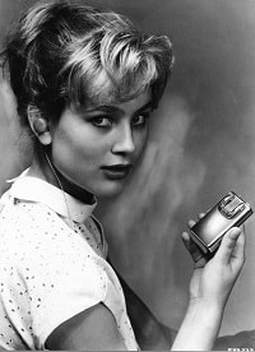|
The power of electrons – right in your vest pocket. Hearing aids feature performance with lower use of power, less noise, and no distortion at high frequencies. As early as the 1920s, great strides were made in amplifier technology, and the many advantages electron tubes had over conventional electrical sound amplification became clear. Even with these advances, the engineers of the time had not yet invented a way to manufacture small, portable tubes that could be used for hearing aids. It was not until World War II and the postwar period that sub-miniature tubes were developed, allowing for lightweight, compact hearing aids that encapsulated the benefits of the new technology in a form small enough to fit in a vest pocket. Siemens made this giant leap in hearing aid technology with the Fortiphon and Phonophor Alpha pocket hearing aids.  Electric hearing aids based on telephone technology began to reach their limits, especially when greater amplification was needed. High frequencies are hugely important for voice transmission, but they presented particular limits for the existing technology. Higher amplification was especially an issue when conventional carbon microphones were used — voices sounded louder, but they were distorted. The combination of sub-miniature tubes and crystal microphones solved this problem while also making it possible to build smaller and more powerful hearing aids. In the late 1940s, Siemens was the distributor for the Fortiphon, a pocket hearing aid based on this technology. The company then developed the similarly designed but even more powerful Phonophor Alpha. Before World War II, a company named Fortiphone was responsible for selling Siemens hearing aids in the UK. Starting in 1949, the roles were reversed for a short time. With Siemens selling the Fortiphon — a pocket hearing aid with sub-miniature tubes and a crystal microphone — on the German market. The sub-miniature tubes developed in the U.S. and in England were not yet available in postwar Germany. Not long afterward, in 1951, Siemens launched its own first hearing aid of this type: the Phonophor Alpha. Both hearing aids benefited from the advantages of the new technology. The three powerful electron tubes used as amplifiers were each about half the length of a wooden matchstick. Equipped with a crystal microphone, these devices delivered significantly clearer sound quality. This was especially apparent at high frequencies, which are key to faithful reproduction of consonants and whole syllables. The Phonophor Alpha had more than 250 parts, but still weighed in at just 175 grams (a little over six ounces) including batteries, and it was almost as small as a pack of cigarettes. Dubbed “pocket hearing aids,” the Alpha and the similarly compact Fortiphon slipped easily into a vest pocket and could even be worn under clothing. Another factor that helped make these hearing aids more discreet was their skin-tone earpieces, which were connected to the unit via a cord in the same color. Various sizes of earphones were available. If the wearer’s ear canal varied greatly from the average form, an impression could be taken in order to produce a custom-fitted earpiece. The Phonophor Alpha was also specifically designed to be easy to use. A tiny dial was used to turn the device on and off and adjust the volume, and a flat slider on the side of the housing could be used to adjust the two frequency responses to the desired tone.
0 Comments
Your comment will be posted after it is approved.
Leave a Reply. |
Categories
All
|
-
products
- Rexton Emerald M 8C RIC
- Rexton inoX CIC 8C
- Rexton Mosaic M 8C BTE
- Rexton Mosaic P 8C BTE
- Rexton Stellar RIC 8C
- Rexton Sterling 8C CIC / IIC
- Rexton Sterling 8C ITE / ITC
- Rexton Emerald XS 8C RIC
- Rexton Emerald S 8C RIC
- Signia Active Pro
- Signia CROS AX
- Signia CROS Hearing Solutions
- Signia Insio Charge&Go AX
- Signia Insio Nx IIC/CIC
- Signia Insio Nx ITC/ITE
- Signia Intuis 3 Family
- Signia Motion Charge&Go X
- Signia Motion 13 Nx/Motion 13 P Nx
- Signia Prompt
- Signia Pure Charge&Go AX & T AX
- Signia Pure 312 AX
- Signia Pure 10 Nx
- Signia Pure 13 BT
- Signia Pure 13 Nx
- Signia Silk X
- Signia Styletto AX
- Signia Styletto X
- SERVICES >
- about
- blog
- Insurance
- contact
|
© 2023 Pure Sound Hearing Aids. All Rights Reserved.
|
Proudly powered by Weebly
-
products
- Rexton Emerald M 8C RIC
- Rexton inoX CIC 8C
- Rexton Mosaic M 8C BTE
- Rexton Mosaic P 8C BTE
- Rexton Stellar RIC 8C
- Rexton Sterling 8C CIC / IIC
- Rexton Sterling 8C ITE / ITC
- Rexton Emerald XS 8C RIC
- Rexton Emerald S 8C RIC
- Signia Active Pro
- Signia CROS AX
- Signia CROS Hearing Solutions
- Signia Insio Charge&Go AX
- Signia Insio Nx IIC/CIC
- Signia Insio Nx ITC/ITE
- Signia Intuis 3 Family
- Signia Motion Charge&Go X
- Signia Motion 13 Nx/Motion 13 P Nx
- Signia Prompt
- Signia Pure Charge&Go AX & T AX
- Signia Pure 312 AX
- Signia Pure 10 Nx
- Signia Pure 13 BT
- Signia Pure 13 Nx
- Signia Silk X
- Signia Styletto AX
- Signia Styletto X
- SERVICES >
- about
- blog
- Insurance
- contact


 RSS Feed
RSS Feed